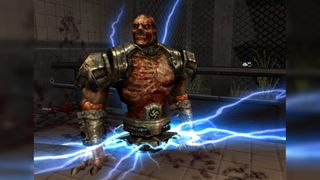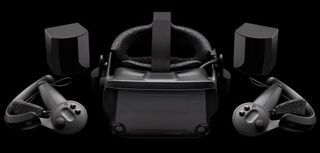AMD hero is giving Return to Castle Wolfenstein a path tracing upgrade
This senior graphics engineer is sinking his soul into a ray tracing update for a Nazi killing cult classic.

One Senior Graphics R&D Engineer at AMD, Dihara Wijetunga, has been posting on his Twitter page about a real-time, path traced version of Return to Castle Wolfenstein (RTCW) coming to PC, called Wolf PT.
Through his own passion and initiative, Wijetunga is bringing ray tracing technology to fans of the game and, as the name suggests, is using path tracing to lighten the load of the real-time lighting effect. The changes to the OG game will include improvements to the much loved, Nazi murdering, first person shooter's lighting and shadows, though from the side-by-side comparison, it looks like a little more than just that will be changing.
I'm so excited to announce my newest project,Wolf PT: A real-time path tracer for Return to Castle Wolfenstein.Based on iortcw with a custom DX12 backend. It's still very early in development, so here's a few comparison shots. Expect more soon! pic.twitter.com/QdC7S0xCeFJune 10, 2022
Keep in mind that these shots come from pretty early development stages, but there could indeed be some brighter spaces emerging in the dankness of Castle Wolfenstein thanks to the new techniques Wijetunga is utilising.
Wolf PT will be based on the open-source iortcw engine, although it'll be coming with it's own custom DX12 backend. Meaning it'll use your CPUs integrated graphics to improve performance. "This is hardware triangle RT with DXR so it requires an acceleration structure," says Wijetunga in the Twitter comments.
After being previously overhauled by fans, the originally Xbox-only game eventually came to Steam. In the process it gained an expanded arsenal and weapon overhauls, better boss fights, and improved AI, among other things. Now, the game will benefit from the joys of path tracing.

Best VR headset: which kit should you choose?
Best graphics card: you need serious GPU power for VR
Best gaming laptop: don't get tied to your desktop in VR
In the comments, Wijetunga notes that he doesn't plan to use "RT for DoF or Motion Blur since the ray budget is so tiny for real-time." Instead of using ray tracing for depth of field effects and motion blur, he plans to spend the small ray budget on "a clean image each frame then add DoF and Motion Blur as a post process effect."
He does admit, however, that he's considering adding caustics as a ray tracing effect. That means light shining through liquid and glass may end up looking really stunning.
The biggest gaming news, reviews and hardware deals
Keep up to date with the most important stories and the best deals, as picked by the PC Gamer team.
Considering this is a game that comes with some of the best flamethrowers found in games, we're looking forward to the final product. Right now, though, there's still a way to go.

Screw sports, Katie would rather watch Intel, AMD and Nvidia go at it. Having been obsessed with computers and graphics for three long decades, she took Game Art and Design up to Masters level at uni, and has been rambling about games, tech and science—rather sarcastically—for four years since. She can be found admiring technological advancements, scrambling for scintillating Raspberry Pi projects, preaching cybersecurity awareness, sighing over semiconductors, and gawping at the latest GPU upgrades. Right now she's waiting patiently for her chance to upload her consciousness into the cloud.
Most Popular





